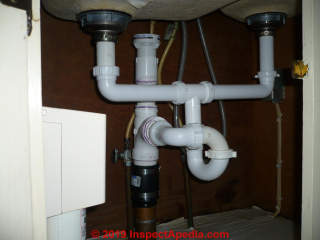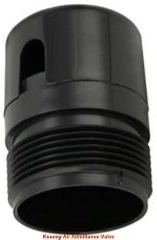 Air Admittance Valve AAV Troubleshooting
Air Admittance Valve AAV Troubleshooting
AAV Repairs: Slow drains, noises, test procedure
- POST a QUESTION or COMMENT about plumbing diagnosing & repairing problems with air admittance valves, studor vents, AAVs & plumbing drains
Air admittance valves or Studor Vent problem diagnosis and repair.
Here we discuss causes and cures for noises traced to the air admittance valve or AAV, the causes and repairs for slow drainage at drains that are vented by an AAV, and we give a simple test procedure useful for determining if the AAV is working and if it is properly sized for the drain system it serves.
This article series explains what an air admittance valve (AAV) or Studor Vent® is and how are they used and gives details about choosing the proper AAV size, loctation, and installation, along with help in troubleshooting AAV or plumbing drain noises, odors, malfunctions.
InspectAPedia tolerates no conflicts of interest. We have no relationship with advertisers, products, or services discussed at this website.
- Daniel Friedman, Publisher/Editor/Author - See WHO ARE WE?
Air Admittance Valves & Studor Valve Troubleshooting, Testing, Repair
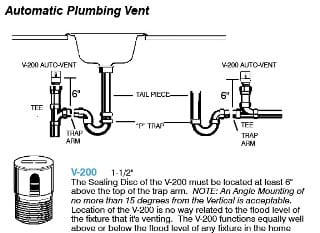
Article Contents
- AAV NOISE DIAGNOSIS & CURE - noisy air admittance valve
- SLOW AAV DRAIN DIAGNOSE & CURE - drain is slow even with AAV installed?
- TEST PROCEDURE for AAVs - diagnose AAV trouble, is the AAV size adequate?
AAV Air-Admittance Valve Noise Diagnosis
Several readers have reported odd noises traced to Air Admittance Valves or Air Admittance Vents. We collect them here to provide some noise diagnosis suggestions.
Above on this page we've already explained that adequate plumbing vents not only help drains to empty properly, they also avoid drain noises like the familiar glub glub sound of a slow drain.
Also see these
Air Admittance Valve noise diagnostic tools
- CLICKING SOUNDS
- PLUMBING DRAIN NOISES
- PLUMBING NOISE CHECKLIST
- PLUMBING SYSTEM NOISE DIAGNOSIS & CURE - home
- POPPING SNAPPING NOISE DIAGNOSIS
- TEMPERATURE CHANGE RELATED NOISES and for a common example
- TAPPING NOISES in BUILDINGS
- TICKING NOISE DIAGNOSIS
- TICKING NOISES
---
On 2021-12-01 by Inspectapedia Com Moderator (mod) - diagnose air admittance vent clicking noises
@Jane,
Noises coming from an air admittance valve or AAV could be caused by a leak into the building drain system somewhere that is causing intermittent air admittance through the AAV - check for subtle leaks like a hard-to-spot running toilet.
Other possible causes of AAV noises are described at
PLUMBING VENT NOISE https://inspectapedia.com/plumbing/Plumbing_Vent_Noise.php
and a remarkable honking or kazoo noise has been traced to AAVs too, as described by Ken Smith · Sept 30, 2021 in a reader post currently found
at PLUMBING VENT NOISE FAQs https://inspectapedia.com/plumbing/Plumbing-Vent-Noise-FAQS.php
He said
I've a non-predictable whistle, kazoo-decompression sound coming from the attic. Studor vent does not go through the roof. It sometimes becomes more frequency during heavy or long-duration storms. Could it be the Studor vent? Or?
Thermal expansion and contraction can also produce plumbing noises including clicks and ticks, particularly if a drain line is
installed without any clearance space where it passes through other building materials.
You might find thermal expansion/contraction noise sources by visual inspection for tight plumbing passages, by relating the time you hear the noise to temperature changes in or outside the building, even wind, and also by using a mechanic's stethoscoope.
Thank you for a helpful question. Please do keep us updated on your progress with this admittance vent noise diagnosis as that will help other readers, and as you may be able to report more observations that will let us offer more suggestions.
I'll collect all of our AAV or admittance valve/vent noises onto this page.
On 2021-11-30 by Jane - Why does our air admittance vent make a ticking sound
Why does our air admittance vent make a ticking sound
On 2019-04-26 by Nick Loche - dripping noise diagnosis at an air admittance valve
@Douglas Rome,
Does the drip noise you describe only occur when you are running water? If this is the case it could possibly be that water pipes are expanding against the holes that the pipes run through and you could wind up chasing a phantom sound forever. If the holes that the water pipes run through are too small or the strapping used is too tight around the pipe this could possibly produce that same sound similar to a drip.
I also agree with [the moderator] in that the AAV must always be accessible.
If it is the AAV one possibility is that the tapping is the valve opening and closing making a noise and in this case run hot water at a very slow but steady stream for 5 minutes and if there is no tapping at all then run the water fully open and if the tapping begins then it is more possibly the AAV Oatey valve making the tapping noise.
Also see DRIPPING WATER SOUND SOURCES - described as tapping
On 2017-04-23 by (mod) - never bury an AAV
I'm not sure it's good practice to bury an AAV in part because it can't be inspected nor replaced if it fails. Also, covering an air admittance valve might block air entry into it, causing drain malfunctions that can be unsafe.
The hazards include more than just poor venting or poor drains: an AAV that jams may also vent dangerous sewer gases into the building. The valve must remain accessible.
I like the stethoscope approach; also look for stains below the area where you hear dripping.
See DRIPPING WATER SOUND SOURCES - described as tapping
On 2017-04-23 by Douglas Rome - our AAV is buried behind drywall but we hear dripping sounds
we did a 1st floor kitchen remodel and had to use an AAV to accommodate a second floor lav. the walls and ceiling were open for a few weeks after the AAV install. in that time we did not notice a leak in the exposed lav piping.
The tapping sound we hear is like you would hear if there was a slow leak and water dripping on drywall ceiling drip drip drip.
The AAV is buried behind drywall and it is a Oatey brand
I don't recall the model number it was purchased at one of the big boxes. I will try a
stethoscope to see if I can pinpoint. thanks, douglas
On 2017-04-17 by (mod) - AAVs do not normally make noise
Douglas
The AAVs I've installed, seen, inspected were rather silent. If you hear a tapping sound and it's for sure coming from the AAV (try a mechanic's stethoscope) then perhaps the valve is indeed sticking or defective.
On 2017-04-17 by Douglas Rome - tapping (dripping) sounds at AAV?
does a AAV make noise? Like a tapping sound while water
is flowing in the drain? Thanks, Douglas
Air Admittance Valve AAV Slow Drain Diagnosis
On 2019-08-14 by (mod) - diagnose slow drainage with an AAV installed
 I don 't think shortening the sink drops (what I call tailpieces) will help this problem - though an experiment would be interesting.
I don 't think shortening the sink drops (what I call tailpieces) will help this problem - though an experiment would be interesting.
Illustration: Studor's Mini-Vent® DFU (Drain Fixture Unit) sizing chart from the STUDOR PRODUCTS MANUAL cited and linked-to above. Studor's Tec-Vent® has the same DFU capacity. Other Studor brand AAVs vary in DFU capacity - more charts are given below.
[Click to enlarge any image]
Your theory about the AAV being too big is interesting too, but I'd be surprised if that's the trouble since the designer of the larger-capacity AAV has to consider that the AAV has to open at lower drainage rates than the maximum that the vent can handle. Your AAV could be too-small, however as we'll discuss here.
Typically an AAV opens at - 0.1 psi and closes at 0 psi or above.
According to the Studor AAV Sizing chart on the label you attached, assuming your kitchen sink drains are 2" diameter your AAV can handle 6 DFUs - more than enough for just two kitchen sinks.
Curiously your Studor Vent label shows a "blank" for the maximum number of DFUs ifyour drain horizontal branch is just 1 1/2" - so your AAV could be too small, but not too big.
Let's both look over the specs some more and let's review the reasons that a drain line may be slow when an AAV has been installed.
Causes of Slow Drains where an Air Admittance Valve AAV is Installed
- Downstream trap:
The most common cause of poor or slow drainage where an Air Admittance Valve has been installed is back pressure in the drain piping system. That can be caused if the AAV has been installed upstream from a drain that is trapped.
The trap downstream from the AAV combined with wastewater flowing down the drain when the AAV-supported fixture is being drained (such as a toilet or large sink) can cause back-pressure that prevents the AAV from opening enough for the drain to flow freely. - Downstream drain blockage:
A second problem that will cause poor drainage when the AAV is installed is a partial drain blockage downstream, usually pretty far downstream, from the fixture being served by the air admittance valve.
An improperly-sloped drain line can also cause the same slow-draining AAV problem as a remote drain blockage. Positive pressure in the drain line. - Missing or blocked conventional roof vent
on the main drain line into which the AAV-served drain ultimately empties. A roof vent may be blocked by debris, frost (in freezing weather), and even a frog (at least I found one there once).
Oatey and Studor make clear that while it is helpful (and sometimes permitted) to install an AAV at a fixture that's otherwise too distant from the building vent system (example would be a kitchen island sink drain or garbage disposer drain in an island sink), the building drain system into which the fixture ultimately empties must be served by a conventional roof vent. - Subtle partial drain blockage
(uncommon) such as a horizontal plastic trap arm that is pushed so far into a drain tee or sink tailpiece tee that it is partly blocking drain flow - similar to #2 above but usually closer to the fixture. - AAV too small for the total wastewater volume:
compare the DFUs (drain fixture units) number with the number of fixtures actually being served by the AAV.
Watch out: In Ryan's sink photo below we see two kitchen sinks draining into a common trap line with a Studor Mini-Vent® AAV installed.
While Ryan's photo of the Studor Mini-Vent label shows a blank at the "Maximum DFUS" column for the 1 1/2" diameter drain line, the company's technical product manual (PDF given above in this article) shows that on a 1 1/2" diameter horizontal drain, the Mini-Vent can handle a MAXIMUM of 3 DFUs.
If Ryan's AAV is installed on a 1 1/2" diameter drain, that AAV may be too small when both sinks are draining at once, as we count 2 DFUs per kitchen sink. If it's installed on a 2-inch diameter drain, it should be OK and the slow drain problem is elsewhere.
See details at PLUMBING DRAIN FIXTURE UNITS DFUs - AAV not installed according to the manufacturer's specifications.
See examples of those details, such as installed with insufficient height above the horizontal drain, installed too far from the vent stack, not installed vertical, etc. in the article above.
Positive Air Pressure Attenuators
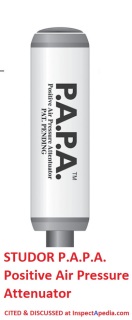 If you cannot solve your positive drain pressure problem and are confident that there are no drain bellies, improper slopes, improper sizings, blockages, vent defects, then you might try installing a positive air pressure attenuator such as Studor's P.A.P.A.™ intended for commercial use. Here is an excerpt from the Studor technical manual cited above:
If you cannot solve your positive drain pressure problem and are confident that there are no drain bellies, improper slopes, improper sizings, blockages, vent defects, then you might try installing a positive air pressure attenuator such as Studor's P.A.P.A.™ intended for commercial use. Here is an excerpt from the Studor technical manual cited above:
The P.A.P.A. device is the perfect complement to STUDOR Air Admittance Valves. Together they form an Engineered System known as “Studor Single Pipe System (SSPS)”, a total solution to building venting requirements.
The Studor AAVs deal with negative pressure in the system while the P.A.P.A. effectively deals with the positive pressure transients. The combination of the two maintains the perfect system balance quickly and efficiently throughout the system preventing siphonage and blowing of traps.
Be sure to review the technical specifications, limitations, and instructions in Studor's technical manual.
I'm going to copy this conversation over to the home article where it may invite helpful comments from others
AIR ADMITTANCE VALVES AAVs inspectapedia.com/plumbing/Air_Admittance_Studor_Vents.php
Well anyhow that's a better trap installation that's less clog likely.
When no air is being drawn IN through the AAV that suggests that the drain is functioning even without air admittance (that can happen though it's not long term reliable) - but you say that with the AAV removed the drain works better. That suggests that the AAV isn't admitting enough air fast enough. (Or less likely there's a downstream blockage).
Often on a two-sink setup I notice that when the big sink is draining air is drawn into the drain through the smaller one - that tells me that there isn't a good air flow into the drain system through the building plumbing vent piping - which is why you added the AAV in the first place.
I'm adding a stack of PDFs on AAVs and their specifications and air admittance valve installation instructions from various manufacturers so that we can review their specifications;
On 2019-08-14 by Russ
For what it is worth, here is a pic of the container the AAV valve came with. It's hard to see the 1 1/2" but it is 3 DFU's max.
I have wondered if the AAV I have is too large for this application but wanted to reach out for advice before buying another brand to see the results. Going back to your original reply, I can shorten the sink drops to raise the assembly too.
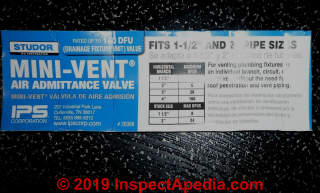
On 2019-08-14 by (mod) - Troubleshooting a Studor AAV that causes too-slow drainage
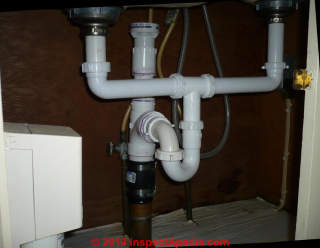 Well anyhow that's a better trap installation that's less clog likely.
Well anyhow that's a better trap installation that's less clog likely.
When no air is being drawn IN through the AAV that suggests that the drain is functioning even without air admittance (that can happen though it's not long term reliable) - but you say that with the AAV removed the drain works better.
That suggests that the AAV isn't admitting enough air fast enough. (Or less likely there's a downstream blockage).
Often on a two-sink setup I notice that when the big sink is draining air is drawn into the drain through the smaller one - that tells me that there isn't a good air flow into the drain system through the building plumbing vent piping - which is why you added the AAV in the first place.
I'm adding a stack of PDFs on AAVs from various manufacturers so that we can review their specifications;
See AIR ADMITTANCE VALVES AAVs https://inspectapedia.com/plumbing/Air_Admittance_Studor_Vents.php
On 2019-08-14 by Russ
Thank you for your promt reply! I did as you suggested below.
First filling both sinks, removed the upper sink drain and using talc to see how the AAV was drawing in air
. I could not see the air being drawn into the AAV, nor could I hear it open. I closed the upper sink drain while still having water in it and removed the lower, repeating the process with the talc on the AAV. Same results with no air being drawn into it.
Then I removed all water from the upper sink and leaving drain open, pulled lower sink drain. The same results with the AAV and the talc. I removed the AAV and held it in the vertical position, gently drawing air by mouth, it does open and gentle blowing, it does close.
I went ahead and removed the extra 90 in the trap, I had that in to create space between the trap and the drain.
See also
PLUMBING DRAIN NOISES- how errors cause trap siphonage, odors, and noises
How to Test the Air Admittance Valve AAV
On 2019-08-14 by (mod) - How to test the Air Admittance Valve AAV - The Bag Test & the Talcum Powder Test
That extra loop trap seems unnecessary; if you shorten the sink tailpieces and raise up the Tee you can go to a single U trap that will improve drainage - but I note that's an independent issue from the slow venting with the Studor in place.
Some plumbers refer to this as a "positive pressure" problem; when water tries to run down the drain it's creating positive pressure in the drain system - that'll close or tend to close the air inlet at the AAV.
Sometimes the problem is that the water running down one side of the sink needs to push air up and out - the Studor or Air Admittance Valve (AAV) only lets air IN - it won't let air OUT.
So let's start by checking what's happening.
Close both sink drains, then fill both sinks, then with an accomplice listening or feeling or blowing talc at the Studor AAV, open one sink drain.
An alternative to blowing talc at the AAV while the fixture is draining, try simply securing a lightweight plastic bag over the AAV, holding it in place with a rubber band.
When you empty the fixture if the bag inflates we know there is a positive pressure problem at the drain - for which solutions will be given above.
If the bag over the AAV compresses or deflates then the AAV is drawing in air.
Try the same experiment with
- one sink drain (the smaller higher one) empty and its strainer removed.
Let me know what happens.
On 2019-08-14 by Russ - slow drainage problem after adding an AAV
I added a Studor Mini AAV to a double kitchen sink that has no other means of venting in hopes of improving the drain speed. After filling the sink and then releasing the water it still drains rather slow but does drain. If I remove the AAV it drains very fast.
There is a main vent line on the house for the toilets and shower but is 25' from the kitchen. If I pour dish soap in the drain with the AAV in place it does drain quickly. Any ideas on things to look at to improve the draining time on the sink would be appreciated.
This Q&A were posted originally
...
Reader Comments, Questions & Answers About The Article Above
Below you will find questions and answers previously posted on this page at its page bottom reader comment box.
Reader Q&A - also see RECOMMENDED ARTICLES & FAQs
On 2021-12-01 by Inspectapedia Com Moderator (mod) - air admittance vent make a ticking sound
@Jane,
Thank you for a helpful AAV noise question.
Please find your question repeated along with our detailed reply now located at
AAV NOISE DIAGNOSIS & CURE - noisy air admittance valve
On 2021-11-30 by Jane
Why does our air admittance vent make a ticking sound
On 2020-11-07 by (mod) - can an AAV be used for venting a toilet?
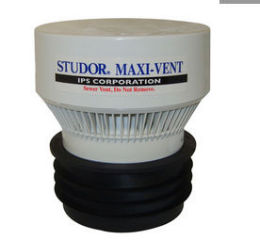 Terry,
Terry,
Yes, possibly. Take a look at the large capacity air admittance valves like the Studor Maxi-Vent shown below and capable of venting at 32 L/sec. at -250 Pa. This AAV is described as a "soil stack vent".
Here is the STUDOR MAXI-VENT PRODUCT SPECIFICATIONS SHEET [PDF]
On 2020-11-06 by terry
can an AAV be used for venting a toilet?
On 2020-01-29 - by (mod) - When draining from the washer box the water backs up and comes out the other side of the kitchen sink.
Ron
Here is some guesswork:
You might have seen in the page top sketch or in the instructions for installing your AAV (Air Admittance Valve) that the minimum height for an AAV is 6" above the top of the trap arm.
I suspect there's a drain line pressure problem - just as you suggest. Perhaps under-sized drains for the volume of wastewter, or under-sized AAVs or as you hint, one that's too low and getting shut by backpressure.
If an AAV is seeing back-pressure such as might occur when other fixtures are dumping into a common drain and in particular when a washing machine is emptying as your hookup may have the washer pumping waste water into the drain under pressure, then that vent is going to close - which means it won't vent the local fixture.
If this were my plumbing installation, and given I can't say I have a clear understanding of your piping and AAVs, I'd pull off one of them, run various drain configurations, and see if I'm actually getting backpressure or water trying to spill out. (Be prepared to close off the vertical riser opening so as not to flood the building)
On the other hand if the problem is clogged drains outside the building you ought to have been seeing that independent of the additional vent.
Do let me know what you find as that will help other readers.
On 2020-01-29 by Ron
Hi I live in a single story house one kitchen one bathroom. we needed to install washing connections/ capabilities in our kitchen so I have a brand new washer box drain line on one kitchen wall and kitchen sink on adjacent wall.
We used an aav to vent the washer box drain line and there has been an older aav on the kitchen sink line. The new aav on washer box is connected on a T connection after the P trap.
The vertical pipe is somewhere around 30” above that T, but the aav at the top is about 5” shorter than the top of the washer box drain pipe. I’ve heard mixed rules on whether the aav has to be higher than the tallest drain line or something?
So The bottom part of the T goes directly into the floor/ crawl space under the house and angles on a 45 down to connect to the drain line coming from the kitchen sink through a Y connection.
This single line then runs down and connects to the main line along with the bathroom sink and toilet lines.
All of these on the main are vented by a large 4” or larger stack that leads through the roof over by the bathroom... so that’s where I figured there was enough venting with this stack that the aav at the washer box would be ok.
So my problem occurs when trying to drain water in either my kitchen sink or my washer box.
When draining from the washer box the water backs up and comes out the other side of the kitchen sink.
When pouring water into the kitchen sink it just backs up immediately at the kitchen sink and no where else.
My question is three fold: is it most likely a block down the line?
Or Is it because I have an old aav under my kitchen sink that isn’t allowing proper venting to the kitchen sink?
Is the aav that is connected to the washer box too low being that it’s not taller than the washer box drain line and is probably 5” shorter than the top of washer box drain pipe?
Your thoughts are much appreciated especially if it’s something else I’m not considering. Thank you
On 2019-12-11 - by (mod) - Can improper p trap depth affect the operation of air admittance valve?
JF
Thank you for the interesting P-trap versus AAV question.
The p-trap depth itself would not be the issue BUT check out the instructions in our page top illustration where it is explained that
"The sealing disc in the V200 must be at least 6" above the top of the trap arm"
The "trap arm" is the horizontal member of the trap. So if a P-trap depth were too short to give sufficient space for a tall-enough air admittance valve vertical pipe, then yes that would be a problem.
On 2019-12-04 by J fletcher
Can improper p trap depth effect the operation of air admittance valve?
On 2019-04-26 by Nick Loche - snaking a grease-blocked drain may fail to open it fully
@Josh,
Is your home on a slab or do you have a basement? Can you see the pipes that run from your sink underneath?
Are the pipes galvanized or plastic? Sometimes snaking the line (even 25 feet) only makes a dime size hole in the grease.
Also, if it is an older home it could be a gray water line. When you pulled the snake back was there a thick coating of sludge or grease?
On 2019-04-26 by Nick Loche
(mod) ,
Agreed. Air Admittance Valves rarely solve this problem of blocked drain lines notwithstanding the cause of it.
Air Admittance Valves can be added to it's own
Watch out section for risk of dangerous sewer gases re-entering the building respectfully.
Oatey's Sure-Vent, Oatey, Studor's Mini-Vent, Studor's Maxi-Vent can all be a risk of possible dangerous sewer gases re-entering the building.
I had a studor and an oatey air admittance valve leak sewer gas odor from time to time so I threaded a cap to the drain connection, since there was a vent to roof within 5 feet of the trap, and the unpleasant sewer gas odor was gone. I since installed a dual seal air admittance valve and no problems since.
I am still not satisfied with air admittance valves in general and it is important that those who read this information are provided with fact based experiences instead of speculation that if you have a slow drain an air admittance valve will solve all your problems.
On 2019-04-13 by (mod) - signs of blocked drain vs. poor venting
When sewage actually backs up into a toilet during use of other plumbing fixtures nearby that's a pretty strong suggestion that the drain system is blocked; it's odd that inadequate venting would go so far as to actually cause drainage backup nearby but I suppose that's also possible.
The latter part of your comment about water being sucked out of other toilets does indeed suggest a combination of a tremendous suction on the drain line combined with no venting working at all.
I speculate that the volume and thus weight of water draining from upstairs combined with no venting is explaining the loss of water downstairs.
Watch out: loss of water from traps at toilets and sinks, showers, etc. risks dangerous sewer gas re-entering the building- risking a methane explosion.
Instead of having more work done by "the builder" who may not be a plumber, you probably need an experienced plumber on site to review the vent system.
Read-up about plumbing vents by noting those articles in the ARTICLE INDEX found above.
On 2019-04-10 by Yuri Hanja
@Josh,
Have a 2 story house. Have 2 upstairs full bathrooms. One bath has problems.
1) when showering the toilet would fill to brim.
2) when toilet is used the flush would not empty.
July 2017 after proving water was not draining properly, the builder tore first floor ceiling down and realigned the drain pipes.
But now problems are returning, including all toilet water( both up and downstairs toilets) being sucked out. We are connected to town sewer system.
On 2018-08-06 by (mod) - signs of drain blockage when the AAV is working
Josh
If the sink drain is backing up and the air admittance valve is working I suspect there is a drain blockage not yet found and cleared. You could confirm that it's not the vent by removing it entirely - an open standpipe under the sink acts as an unobstructed air entry point.
If the drain still backs up then we figure it's not an air admittance problem.
On 2018-08-06 by Josh
I have a studor minivent on my double sinks with a dishwasher connected.
I have snaked the pipes 25 feet but my sink backs up really quick. Ive replaced the studor vent with the same problem. The valve is rated to 160 dfu I dont know what else to do.
...
Continue reading at PLUMBING VENT CODES, DEFINITIONS, TYPES or select a topic from the closely-related articles below, or see the complete ARTICLE INDEX.
Or see these
Recommended Articles
- AIR ADMITTANCE VALVES AAVs - home
- AIR ADMITTANCE VALVE AAV DEFINITION
- AAV COMPARED with PLUMBING VENT - what's the difference?
- AAV CAPACITIES & SIZING GUIDE - choose the right air admittance valve
- AIR ADMITTANCE VALVE AAV REPAIR GUIDE - noises, slow drains, test procedure
- AIR ADMITTANCE VALVES CODES, STANDARDS, MANUALS
- PLUMBING DRAIN FIXTURE UNITS DFUs
- PLUMBING DRAIN NOISES - basics of proper plumbing vent piping and how errors cause trap siphonage, odors, and noises
- PLUMBING VENT CODES, DEFINITIONS, TYPES
- DEFINITION of a Plumbing Stack Vent
- DIFFERENCE Between Soil Stack & Waste Stack
- DIRECT VENTED Plumbing Fixtures
- DISTANCE: vent piping be located from a plumbing fixture?
- DRAIN & VENT SIZE & DISTANCES to FIXTURES
- FUNCTION: how plumbing vent piping works
- ROUTING SPECS for PLUMBING VENTS
- VENT DISTANCES to BUILDING FEATURES
- WET VENTED Plumbing Fixture
- PLUMBING VENT REPAIR
- TAPPING NOISES in BUILDINGS
- TICKING NOISE DIAGNOSIS
Suggested citation for this web page
AIR ADMITTANCE VALVE AAV REPAIR GUIDE at InspectApedia.com - online encyclopedia of building & environmental inspection, testing, diagnosis, repair, & problem prevention advice.
Or see this
INDEX to RELATED ARTICLES: ARTICLE INDEX to PLUMBING SYSTEMS
Or use the SEARCH BOX found below to Ask a Question or Search InspectApedia
Ask a Question or Search InspectApedia
Try the search box just below, or if you prefer, post a question or comment in the Comments box below and we will respond promptly.
Search the InspectApedia website
Note: appearance of your Comment below may be delayed: if your comment contains an image, photograph, web link, or text that looks to the software as if it might be a web link, your posting will appear after it has been approved by a moderator. Apologies for the delay.
Only one image can be added per comment but you can post as many comments, and therefore images, as you like.
You will not receive a notification when a response to your question has been posted.
Please bookmark this page to make it easy for you to check back for our response.
IF above you see "Comment Form is loading comments..." then COMMENT BOX - countable.ca / bawkbox.com IS NOT WORKING.
In any case you are welcome to send an email directly to us at InspectApedia.com at editor@inspectApedia.com
We'll reply to you directly. Please help us help you by noting, in your email, the URL of the InspectApedia page where you wanted to comment.
Citations & References
In addition to any citations in the article above, a full list is available on request.
- International Mechanical Code (IMC), International Code Council [888] 422-7233, Op. Cit.
- International Plumbing Code (IPC)Op. Cit.
- In addition to citations & references found in this article, see the research citations given at the end of the related articles found at our suggested
CONTINUE READING or RECOMMENDED ARTICLES.
- Carson, Dunlop & Associates Ltd., 120 Carlton Street Suite 407, Toronto ON M5A 4K2. Tel: (416) 964-9415 1-800-268-7070 Email: info@carsondunlop.com. Alan Carson is a past president of ASHI, the American Society of Home Inspectors.
Thanks to Alan Carson and Bob Dunlop, for permission for InspectAPedia to use text excerpts from The HOME REFERENCE BOOK - the Encyclopedia of Homes and to use illustrations from The ILLUSTRATED HOME .
Carson Dunlop Associates provides extensive home inspection education and report writing material. In gratitude we provide links to tsome Carson Dunlop Associates products and services.


